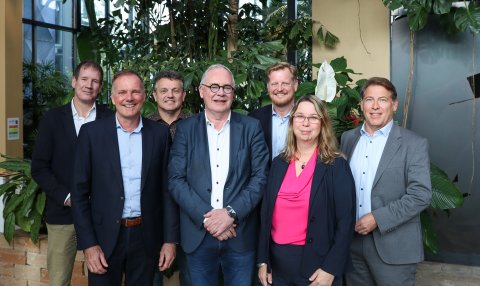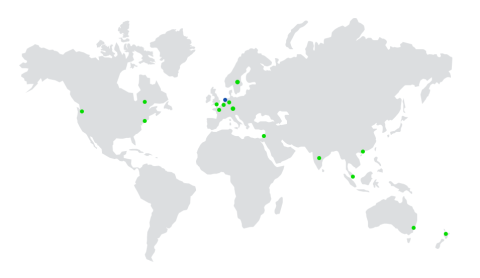
What is a CMMS?
A computerized maintenance management system or CMMS is software that helps organizations manage and maintain their maintenance operations more effectively. It can be used to track, schedule, and streamline maintenance activities for equipment, facilities, and other assets.
CMMS solutions provide a centralized platform for maintenance managers, technicians, and other stakeholders to plan, execute, and monitor maintenance tasks. In the context of buildings, CMSS software helps real estate owners and service providers to operate and maintain their buildings and technical assets in a beneficial, cost effective, and compliant way.
This page discusses how implementing a CMMS system can facilitate the forecasting, planning, and evaluating any type of maintenance work, either contracted or delivered by internal maintenance staff.
Curious to see the system for yourself? Watch a 20 minute Planon CMMS demo video now.
Five processes that ensure you get the most from your CMMS software
Due to the complexity of maintenance legislation, execution of maintenance work needs to be planned, monitored, and documented with great care. CMMS supports maintenance planners, engineers, and supervisors with tools and technology that ensure streamlined and compliant execution of work.
These are the most important CMMS software features every CMMS needs to support:
1. Scenario planning, resources and dispatching
CMMS systems include scenario planning tools and graphical plan boards to visualize upcoming work and to optimize cmms maintenance planning. Drag and drop functions allow you to move work, postpone activities, merge maintenance jobs or split activities. Impact on workloads and budgets is recalculated and visualized immediately.
CMMS software supports resource planning to allocate maintenance teams or individual engineers to work, based on people’s availability, workloads, competencies and skills. Once the work is planned and allocated, CMMS supports automatic dispatching to the applicable engineers by using workflow tools, automated job tickets, and mobile solutions.
2. Work order management
All generated maintenance work and job tickets should be stored in a central work order repository. This allows users to easily search for open, planned, or closed maintenance work by building, asset, engineer or any other relevant search criteria. For each individual work order, details such as status updates, time spent, materials used, documentation, follow-up actions, planned budget, and actual costs are registered and available for reporting.
The CMMS software allows engineers to easily access their individual work, update or close job tickets, or query relevant asset information or maintenance procedures and checklists.
3. Health and safety
Maintenance is essential to keep equipment, buildings, and the work environment safe and reliable. Inadequate maintenance can lead to dangerous situations, accidents, and health problems. The maintenance process is also a high-risk activity and it must be performed safely, with appropriate protection of maintenance workers.
CMMS software supports compliance with health and safety regulations to ensure both a healthy workplace environment and a safe execution of maintenance work. CMMS includes health and safety documentation, procedures, checklists, and workflows for any type of maintenance work to ensure compliance.
4. Mobile solutions
Maintenance engineers need access to their work anytime and anywhere, both in connected areas and places without internet. CMMS mobile maintenance supports field engineers in executing their daily work efficiently. Engineers can use their mobile device or smart phones to select their next job, read specific work instructions, query asset-specific information, capture time and materials used, complete a job, and add a customer sign-off.
Mobile maintenance includes health and safety checks along with dynamic risk assessments to ensure compliance with legislation and to reduce any potential risks involved.
Watch the video to learn more about the benefits and features of Planon Mobile Field Services.
Planon is a true mobile CMMS as it is designed to support all mobile devices, so maintenance personnel can access and update maintenance data while on the go, providing real-time information and enhancing the efficiency of maintenance operations. Users can use their mobile devices to create work orders, view equipment histories, check maintenance schedules, and perform other maintenance-related tasks from anywhere, which can improve overall productivity and reduce downtime.
5. Monitoring and analyses
To ensure efficient maintenance, the monitoring of dashboards and analyses help maintenance managers identify potential cost savings and improvement opportunities. CMMS software offers a broad range of management dashboards and key performance indicators (KPI’s) to analyze the performance of your assets and effectiveness of your maintenance programs and investment.
Online dashboards also allow you to monitor and evaluate the performance of providers, to determine if they meet contracted service level agreements (SLA’s), uptimes, times to complete, costs and quality. These CMMS dashboards give maintenance planners immediate insight into actual operations, potential risks, and deviations in work execution.
If you would like to learn more, please schedule a Planon CMMS demo.
How to save costs by avoiding maintenance?
Reactive maintenance work, mostly caused by asset failures or maintenance backlogs, is expensive because it is not planned or budgeted but needs immediate action. Time based maintenance allows maintenance experts to plan and execute maintenance activities based on warranties, qualitative requirements, or compliancy and legislation. This type of time-based maintenance reduces reactive work drastically, including the corresponding costs.
However, more than 40% of this planned maintenance is still not executed on time, either too early or too late. Too late causes expensive reactive work, too early is a waste of investment and time. A Computerized Maintenance Management System ensures a timely execution of maintenance work with objective asset condition assessments.
Once the actual condition of an asset is assessed and scored, the CMMS automatically calculates and schedules the needed maintenance. Extensive maintenance libraries of activities, deterioration curves, and cost catalogues feed the CMMS software with data and intelligence to ensure just-in-time maintenance execution.
The ultimate just-in-time maintenance is supported with real time tracking of actual assets statuses and data. Intelligent buildings and smart assets are connected with your IT network and send data about production hours, failure statuses, production numbers, and energy consumption in real time to your CMMS. Based on preset thresholds or historical information, the CMMS can accurately forecast relevant maintenance jobs, their costs, and timing.
A truly holistic view can help you avoid unnecessary maintenance and reduce associated costs. When combining your CMMS functionality within an Integrated Workplace Management System (IWMS), you can analyze maintenance relevancy related to your real estate strategy, space occupancy, user behavior, or sustainability targets.
Why maintain a building that will be demolished? Why maintain HVAC equipment in spaces that are not occupied? Why not reduce maintenance effort by combining energy measures with preventative or condition-based maintenance? This holistic and integrated view of maintenance is the key to success for cost efficiency, business continuity, and a sustainable maintenance strategy.
What you need to know about CMMS software and Enterprise Asset Management
In capital-intensive industries such as utilities, manufacturing, pharmacy, healthcare, and real estate, physical assets form a significant portion of the organizations’ capital and investment. Any failure is disruptive and extreme costly. In addition, the management and maintenance of assets must comply with stringent occupational, environmental, and safety regulations.
Enterprise Asset Management (EAM) software and Life Cycle Asset Management (LCAM) tools support organizations in maximizing the return on investment from their asset repository by increasing asset productivity and minimizing total costs of ownership. These costs include assets design, acquisition or replacement, operations, maintenance and demolishment.
In most cases asset operations (including energy consumption) and technical maintenance reflect over 80% of these lifecycle costs. That makes CMMS systems a core functionality of Enterprise Asset Management as it:
- provides decision support information on whether it is more cost-effective to continue maintaining or replacing a failing, high cost, or less productive asset
- schedules time-based or condition-based preventative maintenance activities that can be prompted by automated triggers such as production hours, consumption metrics, or technical conditions
- supports a full asset lifecycle documentation including maintenance instructions, health and safety procedures, warranties, maintenance, and costs history
- ensures the proper execution of both preventative and reactive maintenance, including resource scheduling, work order dispatching, mobile support for field engineers, and monitoring time, budget and quality
- supports analysis of any asset or equipment regarding costs, performance, reliability, downtime, utilization, time to repair, and forecasted maintenance
In Facility Management and Real Estate, CMMS functionality is in most cases embedded in an Integrated Workplace Management System (IWMS). These solutions include EAM related processes aiming at FM and RE relevant assets such as buildings, workplaces, technical equipment, and installations.
Our global success stories

Singapore Management University
Haslinda Shamsudin ‒ Project Manager, Office of Campus Development: “Planon’s IWMS has provided us with an efficient, real-time solution to our workplace and facilities challenges.”
Explore now
U.K. University selects Planon’s CAFM Software
Planon is pleased to announce that the University of Leeds has selected Planon’s Universe Computer Aided Facilities Management (CAFM) software. The solution includes BIM integration, Space and Lease Management, and Asset and Maintenance Management.
Read more























